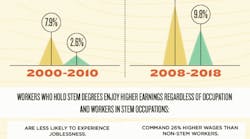It seems nowadays you can't turn a corner without someone mentioning STEM. After all, in a world where technology is entering every facet of life, educating children about STEM fields isn't just helpful - it's necesary. But before we can tackle the issues facing STEM education, just what is it?
STEM education is a K-12 interdisciplinary approach that integrates the areas of Science, Technology, Engineering and Mathematics rather than teaching each subject area in isolation. STEM education uses real-world applications and is driven by problem solving, discovery, exploratory project/problem-based learning, and student-centered development of ideas and solutions.
As technology is becoming evermore present in workfields across the country and will continue to grow, every child will need a comprehensive understanding of STEM, regardless of their chosen career paths. Not to mention it pays to be interested in STEM. According to the U.S. Department of Labor, STEM occupations pay nearly double that of all other careers.
Although many people simply lack interest in the four key areas that comprise STEM, it's undeniable that our future is shifting further and further in its direction. The U.S. Department of Commerce reports that STEM occupations are projected to grow by 17 percent from 2008 to 2018, compared to 9.8 percent growth for non-STEM occupations.
Despite the current low number of students pursuing STEM careers, research shows that those numbers are growing, partly thanks to initiatives like this one by the Clinton Foundation. A modern workforce starts with modern education, and acknowledging the trends is the first step.





